|
|
|
|||
|
|
||||
|
|
||||
| PLANS - Rocket-powered Aircraft | ||||
|
|
HOME | SITE MAP | FORUM | CONTACT |
|
||
|
ABOUT | MOTORS | MODELS | ARCHIVE | HISTORY | STORE | FAQ | LINKS
Construction and operation | Kits | Plans: Fixed Wing Aircraft | Plans: VTOL Craft - Cars - Boats |
|
|
|
|
|
|||
|
The Rocketeers
 Before the advent of Jetex motors and aircraft that were specifically designed for them, a number of designers published plans for rocket-powered aircraft. In some cases, these were scale models of the new breed of jet fighters. Other designs were freely imaginative creations exploiting the unique characteristics of rocket propulsion. On this page, we've gathered a comprehensive selection of plans and descriptions of these pioneering craft, arranged in chronological order. |
The heading illustration is adapted from an article by Howard Boys in Aeromodeller, July 1947, page 466, and shows him launching his 'Flaming Ptero', perhaps the most famous of all the rocket-powered planes. |
|
|
|
|
|
|
|||
|
Ott’s Rocket-ship
Click image to view or download large dimensioned plan and instructions  Joe Ott’s first rocket-ship had rounded wingtips and a twin-wheel undercarriage. On later mono-wheel versions [as shown above, labelled M3], reduced dihedral was used and wingtip skids were standard. Colour scheme was all white with black struts and red fuselage decoration.
- Aeromodeller, Jan. 1993 (p. 13)
|
Aeromodeller in January 1993 published this 1930 plan for Joe Ott’s Rocket-ship, in Alex Imrie’s Vintage Corner’. Imrie introduced Ott’s pioneering model with these notes:
|
|||
|
|
|
|||
|
Cole’s Rocket Plane
Click image to view or download large dimensioned plans and building and flying hints from Dick Cole 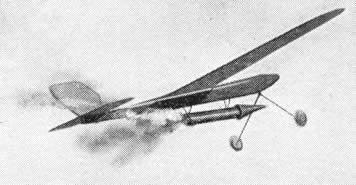
- Modern Mechanix and Inventions, Jan. 1933 (p. 130)
|
Dick Cole designed this formidable 36 in. wingspan craft, powered by a "1-lb. rocket … obtained from any dealer in fireworks", and claimed that :
Prudently, he warned that “experiments should not be carried on near any buildings or in an area where grass fires may be started”, sensible advice that was somewhat weakened by an accompanying photograph showing the craft, trailing fiery smoke, headed towards obviously wooded areas. |
|||
|
|
|
|||
|
Haase’s Rocket Plane
Click image to view or download large dimensioned plan 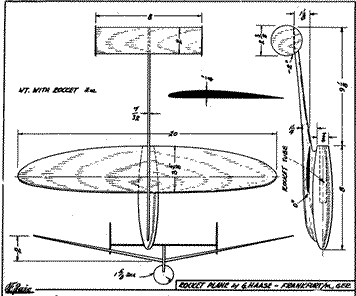
- Frank Zaic’s 1938 Model Aeronautic Yearbook (p. 127)
|
G Haase of Frankfurt, Germany, designed this 20" all-balsa rocket plane. Frank Zaic was sufficiently impressed by it to include it in his Laurence Sparey, in the United Kingdom, was another who was impressed by Haase’s design, using it (with its wings clipped) as the inspiration for his own 1944 "Rocket Plane" (see below). |
|||
|
|
|
|||
|
Negri’s Rocket Plane
Click image to view or download large dimensioned plan 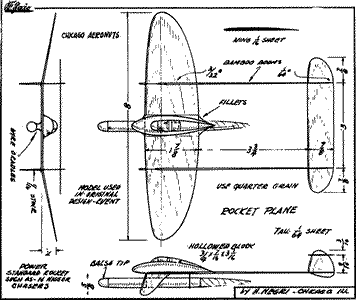
- Frank Zaic’s 1938 Model Aeronautic Yearbook (p. 127)
|
This little 8" twin-boom model was designed by N Negri of the 'Chicago Aeronuts'. It is made entirely of quarter-grain sheet balsa, apart from the bamboo booms. Frank Zaic thought it worthy of inclusion in his The rocket is supported beneath the craft in a wire cradle. As for the actual type of rocket to be employed, the plan advises the use of 1¢ aerial torpedoes. |
|||
|
|
|
|||
|
Singer Craigie’s
A-M Rocket Plane
Click image to view or download large dimensioned plan 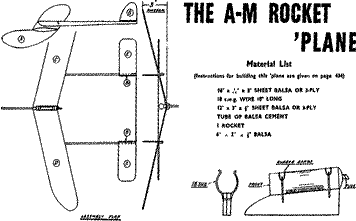
- Aeromodeller, Jan. 1993 (p. 14)
|
The Aeromodeller issue of January 1993 reprinted this June 1939 plan of its eponymous rocket plane, quoting this advice on launching it from the designer, J R Singer Craigie:
Alex Imrie, writer of the ‘Vintage Corner’ which reintroduced the plan, remarked on the coincidence that the other model on Aeromodeller’s free plan in June 1939 was a beginner’s duration flyer by Howard Boys, whose later rocket designs appear elsewhere on this page. |
|||
|
|
|
|||
|
Engelman’s Spitfire
Click image to view or download large dimensioned plan 
- Model Airplane News, Sep. 1941
|
Tom Engelman, of the 'Santa Ana Birdmen' designed his all-sheet Spitfire to rise off ground, powered by a "five or ten cent 2 ounce rocket". "[It] climbs to an altitude of 150 ft., turning in flights of over one minute". The plan also gives details of how to construct the tube for mounting the rocket. |
|||
|
|
|
|||
|
Sparey’s Rocket Plane
Click image to view or download large dimensioned plan and article about Sparey’s exploits 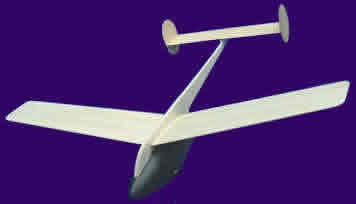
- Model and photograph by Peter Tolhurst
|
Laurence Sparey’s plan for his Rocket Plane was published in the July 1944 issue of the Percival Marshall publication Model Engineer, in its ‘Model Aircraft’ section. Sparey based his design on “a German rocket model of 1936”, undoubtedly the Haase Rocket Plane, depicted above. Peter Tolhurst, who contributed the plan and information, has reconstructed Sparey’s craft for Rapier power (see left). |
|||
|
|
|
|||
|
Boys’ Flaming Ptero
Click image to view or download large dimensioned plan and Boys’ instructions for making the ‘propulsion units’ 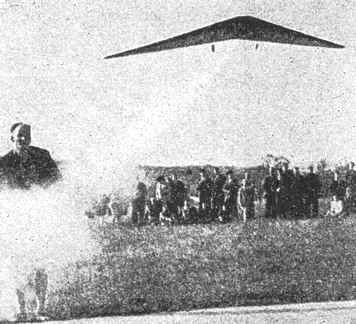 The Devil an aeromodeller would be………
Howard Boys re-appears at Eaton Bray from a cloud of blue smoke.
The Devil an aeromodeller would be………
Howard Boys re-appears at Eaton Bray from a cloud of blue smoke.
Aeromodeller, Nov. 1946
|
Howard Boys published the plan of his little rocket propelled flying wing, the Flaming Ptero, in Model Engineer in 1946. It resembles Doug McHard’s 1937 indoor flying wing, plans of which had appeared in the SMAE Journal shortly before it became Model Aircraft. Boys’ plan carries full instructions for formulating rocket fuel and making the rockets. These were clearly based on Sparey’s methods, but Boys' units are smaller and simplified. |
|||
|
|
|
|||
|
Latham’s Glirt
Click image to view or download large dimensioned plan and building and flying hints from Mr Latham 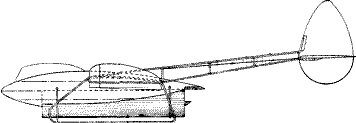
Aeromodeller, Nov. 1946
|
Glirt is a semi-scale twin-boom rocket plane designed by P A Latham. His plan and building and flying hints were published in Aeromodeller in November 1946. The illustration at left plainly shows the bulky rocket motor nestling beneath Glirt. Mr Latham was prudent enough to include an injunction not to "use explosive rockets !". |
|||
|
|
|
|||
|
Selwyn’s Astral
Click image to view or download large dimensioned plan 
Aeromodeller, Nov. 1946
|
This advertisement for the “marvellous Rocket Plane” “now in production” by Astral Mills appeared in the November 1946 issue of Aeromodeller. Eighteen months later, the same magazine carried the announcement of the first Jetex motors, and the Astral Rocket Plane went OOS. It was designed by one "Royston B. Selwyn". The editor of SAM Speaks, August 1997 wrote that "Doug McHard points out that the name of the designer of the Astral rocket model was an anagram of 'TOWNER' and 'BOYS'. He thinks they may have been hiding from the law – that on the use of fireworks!" However, there’s more to the name than an anagram of the names of the two law-evaders – the letters 'SLYN', to be precise. What can they signify? The Astral Rocket Plane itself was advertised at a price of 6s. 6d., “plans only” 1s. 6d., and “rockets separate” (“which have received offical sanction”) 7½d. each. |
|||
|
|
|
|||
|
Boys’ Vampire
Click image to view or download large dimensioned plan and an article on rocket models by Howard Boys 
- Powakits leaflet, 1947
(p. 528)
|
This scale De Havilland 100 Vampire was designed by Howard Boys for use with rocket units that he marketed through his Powakits company. He regarded twin boom craft as particularly "suitable for rocket drive", given that they had "plenty of space behind the centre of gravity, so that the efflux can be directed away from the model". |
|||
|
|
|
|||
|
Boys’ Swallow
Click image to view or download large dimensioned plan and an extract from an article on rocket models by Howard Boys 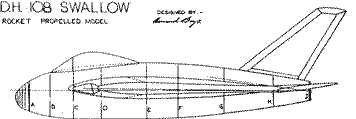
- Powakits leaflet, 1947
(p. 528)
|
This scale De Havilland 108 Swallow was another Howard Boys design obtainable from Powakits. He also favoured tailless models as "suitable for rocket drive", since it was "possible […] to fit a rocket in the tail end of a model. I have managed this very successfully in a scale model of the D.H. Swallow." |
|||
|
|
|
|||
|
Cockle’s Vampire
Click image to view or download large dimensioned plan and building hints from A J Cockle 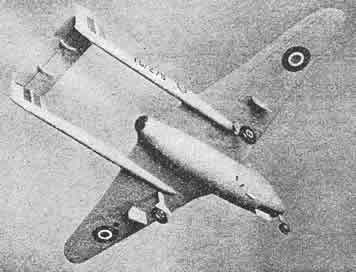
- Aeromodeller, Aug. 1947
(p. 528)
|
This scale De Havilland 100 Vampire, designed by A J Cockle, was published in Aeromodeller in August 1947, just ten months before the Jetex motors were released onto the retail market. Its 40 in. wingspan gave it, according to the plan, a 1 in. to the foot scale. Fully sheeted, it weighed 12 oz. ("without rocket"), giving a wing loading of 7.2 oz./sq. ft. A fixed undercarriage enabled it to take off, in Cockle’s phrase, "like a 'Vampire'". It boasted such details as a sliding cockpit cover and (mock) elevator counter-balances. The accompanying article gave no flying hints and no details of the motor. Indeed the plan describes it as a "petrol driven model", yet has dotted lines in the centre of the fuselage showing the "position of rocket" and an outline of the fused rocket end emerging from the rear of the fuselage. |
|||
|
|
|
|||
|
|
|
|
|
|
|
|
Acknowledgements Ott’s Rocket-ship: - Aeromodeller article and plan from Peter Tolhurst Haase’s Rocket Plane: Negri’s Rocket Plane: - Frank Zaic’s 1938 Model Aeronautic Yearbook plans from Ben Nead A-M Rocket Plane: Sparey’s Rocket Plane: - SAM Speaks article and plan, and model photograph from Peter Tolhurst Engelman’s Spitfire: - Model Airplane News plan from Carlo Godel Boys’s Flaming Ptero: Selwyn’s Astral: - SAM Speaks article and plans from Peter Tolhurst and Rocky Simmonds Latham’s Glirt: Boys’s Vampire: Boys’s Swallow: Cockle’s Vampire: - Aeromodeller articles, plans and additional information from Rocky Simmonds |
|
|
|
|
ABOUT | MOTORS | MODELS | ARCHIVE | HISTORY | STORE | FAQ | LINKS |
|
|
Terms of Use
|
Queries? Corrections? Additions?
Please
contact us.
|
|